Numerical Simulation on the Structural Design of a Multi-Pore Water Diffuser during the External Ice Melting Process of an Ice Storage System
Abstract
:1. Introduction
2. Mathematics Model
2.1. Computational Domain
2.2. Model Assumptions and Governing Equations
2.3. Boundary Conditions
2.4. Grid Independence Test and Model Validity
3. Results and Discussion
3.1. Influence of the Number of Trunk Pipes
3.2. Influence of the Number of Perforated Pores
3.3. Influence of the Diameter of the Diffuser
3.4. Influence of an Operational Parameter on External Ice Melting Process
4. Conclusions
Author Contributions
Funding
Institutional Review Board Statement
Informed Consent Statement
Conflicts of Interest
Nomenclature
| density, kg m−3 | |
| dynamic viscosity, Pa s−1 | |
| pressure, Pa | |
| velocity, m s−1 | |
| t | Time, s |
| T | Temperature, °C |
| turbulent kinetic energy | |
| turbulent kinetic energy due to buoyancy, J | |
| Gk | turbulent kinetic energy due to velocity steps in the bottom laminar flow, J |
| diffusion coefficient | |
| specified heat, J kg−1K−1 | |
| thermal conductivity, W m−1 K−1 | |
| turbulent flow energy | |
| Constant | |
| Constant | |
| Constant | |
| Source terms of the equations | |
| Source terms of the equations | |
| 0.09 | |
| 1.00 | |
| 1.30 | |
| Volume fraction of the liquid phase | |
| g | Gravity vector, kg s−1 |
| Turbulent energy Prandtl number |
References
- Saffari, M.; de Gracia, A.; Fernández, C.; Belusko, M.; Boer, D.; Cabeza, L.F. Optimized demand side management (DSM) of peak electricity demand by coupling low temperature thermal energy storage (TES) and solar PV. Appl. Energy 2018, 211, 604–616. [Google Scholar] [CrossRef] [Green Version]
- Vetterli, J.; Benz, M. Cost-optimal design of an ice-storage cooling system using mixed-integer linear programming techniques under various electricity tariff schemes. Energy Build. 2012, 49, 226–234. [Google Scholar] [CrossRef]
- Rismanchi, B.; Saidur, R.; Masjuki, H.H.; Mahlia, T.M.I. Energetic economic and environmental benefits of utilizing the ice thermal storage systems for office building applications. Energy Build. 2012, 50, 347–354. [Google Scholar] [CrossRef]
- Wang, Y.; Wang, X.; Fan, Y.; He, W.; Guan, J.; Wang, X. Numerical Investigation of Tapered Flow Field Configurations for Enhanced Polymer Electrolyte Membrane Fuel Cell Performance. Appl. Energy 2022, 306, 118021. [Google Scholar] [CrossRef]
- Wang, Y.; Xu, H.; Wang, X.; Gao, Y.; Su, X.; Qin, Y.; Xing, L. Multi-sub-inlets at cathode flow-field plate for current density homogenization and enhancement of PEM fuel cells in low relative humidity. Energy Convers. Manag. 2022, 252, 115069. [Google Scholar] [CrossRef]
- Lizana, J.; Chacartegui, R.; Barrios-Padura, A.; Ortiz, C. Advanced low-carbon energy measures based on thermal energy storage in buildings: A review. Renew. Sustain. Energy Rev. 2018, 82, 3705–3749. [Google Scholar] [CrossRef]
- Parra, D.; Swierczynski, M.; Stroe, D.I.; Norman, S.A.; Abdon, A.; Worlitschek, J.; Patel, M.K. An interdisciplinary review of energy storage for communities: Challenges and perspectives. Renew. Sustain. Energy Rev. 2017, 79, 730–749. [Google Scholar] [CrossRef]
- Wang, S.; Jin, L.; Han, Z.; Li, Y.; Ou, S.; Gao, N.; Huang, Z. Discharging performance of a forced-circulation ice thermal storage system for a permanent refuge chamber in an underground mine. Appl. Therm. Eng. 2017, 110, 703–709. [Google Scholar] [CrossRef]
- Carbonell, D.; Philippen, D.; Haller, M.Y.; Brunold, S. Modeling of an ice storage buried in the ground for solar heating applications. Validations with one year of monitored data from a pilot plant. Sol. Energy 2016, 125, 398–414. [Google Scholar] [CrossRef]
- Ge, M.; Li, Z.; Wang, Y.; Zhao, Y.; Zhu, Y.; Wang, S.; Liu, L. Experimental study on thermoelectric power generation based on cryogenic liquid cold energy. Energy 2021, 220, 119746. [Google Scholar] [CrossRef]
- Korti, A.I.N. Numerical heat flux simulations on double-pass solar collector with PCM spheres media. Int. J. Air-Cond. Refrig. 2016, 24, 1650010. [Google Scholar] [CrossRef]
- Zhao, Y.; Fan, Y.; Li, W.; Li, Y.; Ge, M.; Xie, L. Experimental investigation of heat pipe thermoelectric generator. Energy Convers. Manag. 2022, 252, 115123. [Google Scholar] [CrossRef]
- Bi, Y.; Yu, M.; Wang, H.; Huang, J.; Lyu, T. Experimental investigation of ice melting system with open and closed ice-storage tanks combined internal and external ice melting processes. Energy Build. 2019, 194, 12–20. [Google Scholar] [CrossRef]
- Karim, M.A. Experimental investigation of a stratified chilled-water thermal storage system. Appl. Therm. Eng. 2011, 31, 1853–1860. [Google Scholar] [CrossRef]
- Wildin, M.W. Performance of stratified vertical cylindrical thermal storage tanks, part I: Scalemodel tank; Part II: Prototype tank. ASHRAE Trans. 1989, 5. [Google Scholar]
- Jirka, G.H.; Harleman, D.R. The Mechanics of Submerged Multiport Diffusers for Bouyant Discharges in Shallow Water; MIT Energy Lab: Cambridge, MA, USA, 1973. [Google Scholar]
- Abessi, O.; Roberts, P.J. Multiport diffusers for dense discharge in flowing ambient water. J. Hydraul. Eng. 2017, 143, 04017003. [Google Scholar] [CrossRef]
- Rawn, A.M.; Bowerman, F.R.; Brooks, N.H. Diffusers for disposal of sewage in sea water. Trans. Am. Soc. Civ. Eng. 1961, 126, 344–384. [Google Scholar] [CrossRef]
- Tang, J.; OuYang, Z.; Shi, Y. Diffuser design and experimental research of a large-scale chilled water storage system. Energy Sources Part A Recovery Util. Environ. Eff. 2021, 43, 1456–1467. [Google Scholar] [CrossRef]
- Ling, J.; Zhao, Y.; Xing, J.; Bai, J. Research on slotted-pipe diffuser of naturally stratified water-storage tank. In Proceedings of the 2011 International Conference on Electric Technology and Civil Engineering (ICETCE), Lushan, China, 22–24 April 2011; pp. 3425–3428. [Google Scholar]
- Chung, J.D.; Cho, S.H.; Tae, C.S.; Yoo, H. The effect of diffuser configuration on thermal stratification in a rectangular storage tank. Renew. Energy 2008, 33, 2236–2245. [Google Scholar] [CrossRef]
- Karim, M.A. Performance evaluation of a stratified chilled-water thermal storage system. World Acad. Sci. Eng. Technol. 2009, 53, 326–334. [Google Scholar]
- Song, J.; Bahnfleth, W.P.; Cimbala, J.M. Parametric study of single-pipe diffusers in stratified chilled water storage tanks (RP-1185). HVACR Res. 2004, 10, 345–365. [Google Scholar] [CrossRef]
- Cui, Y.; Xia, R.; Kong, Y. Modelling and structure optimisation on throttle tube of pre-throttle water distributor. Int. J. Model. Identif. Control 2020, 36, 248–255. [Google Scholar] [CrossRef]
- Cui, Y.; Kong, Y.; Xia, R. Modelling and experimental study on hierarchical throttling water distributor. Int. J. Model. Identif. Control 2020, 36, 126–135. [Google Scholar] [CrossRef]
- Tang, J.; Shi, Y.; OuYang, Z. Optimization design of the octagonal water diffuser with uniform flow orifice plate. J. Energy Storage 2021, 44, 103374. [Google Scholar] [CrossRef]
- Zachár, A. Investigation of a new tube-in-tube helical flow distributor design to improve temperature stratification inside hot water storage tanks operated with coiled-tube heat exchangers. Int. J. Heat Mass Transf. 2013, 63, 150–161. [Google Scholar] [CrossRef]
- Jia, D.; Pei, X.; Liu, H.; Sun, F. Research on the flow control strategy of water distributor in Water Injection Well. In Proceedings of the 33rd Chinese Control Conference, Nanjing, China, 28–30 July 2014; pp. 4993–4996. [Google Scholar]
- Kopparthy, S.; Mansour, M.; Janiga, G.; Thévenin, D. Numerical investigations of turbulent single-phase and two-phase flows in a diffuser. Int. J. Multiph. Flow 2020, 130, 103333. [Google Scholar] [CrossRef]
- Bleninger, T.; Perez, L.M.; Milli, H.; Jirka, G.H. Internal hydraulic design of a long diffuser in shallow water: Buenos Aires sewage disposal in Rio de la Plata estuary. Proc. XXXI IAHR Congr. 2005, 219–220. Available online: http://www.koreascience.or.kr/article/CFKO200507523367703.page?&lang=en (accessed on 20 January 2022).
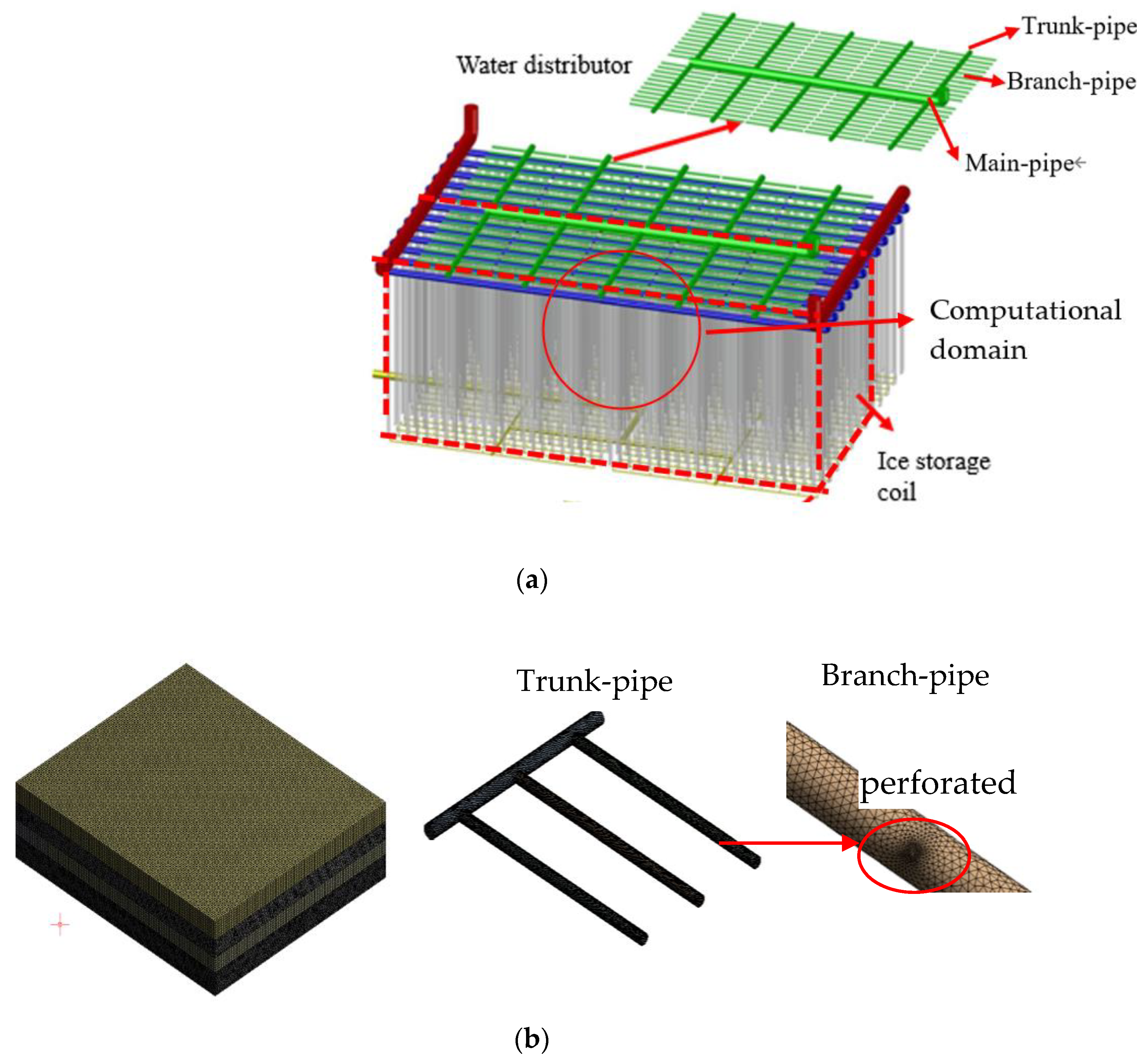

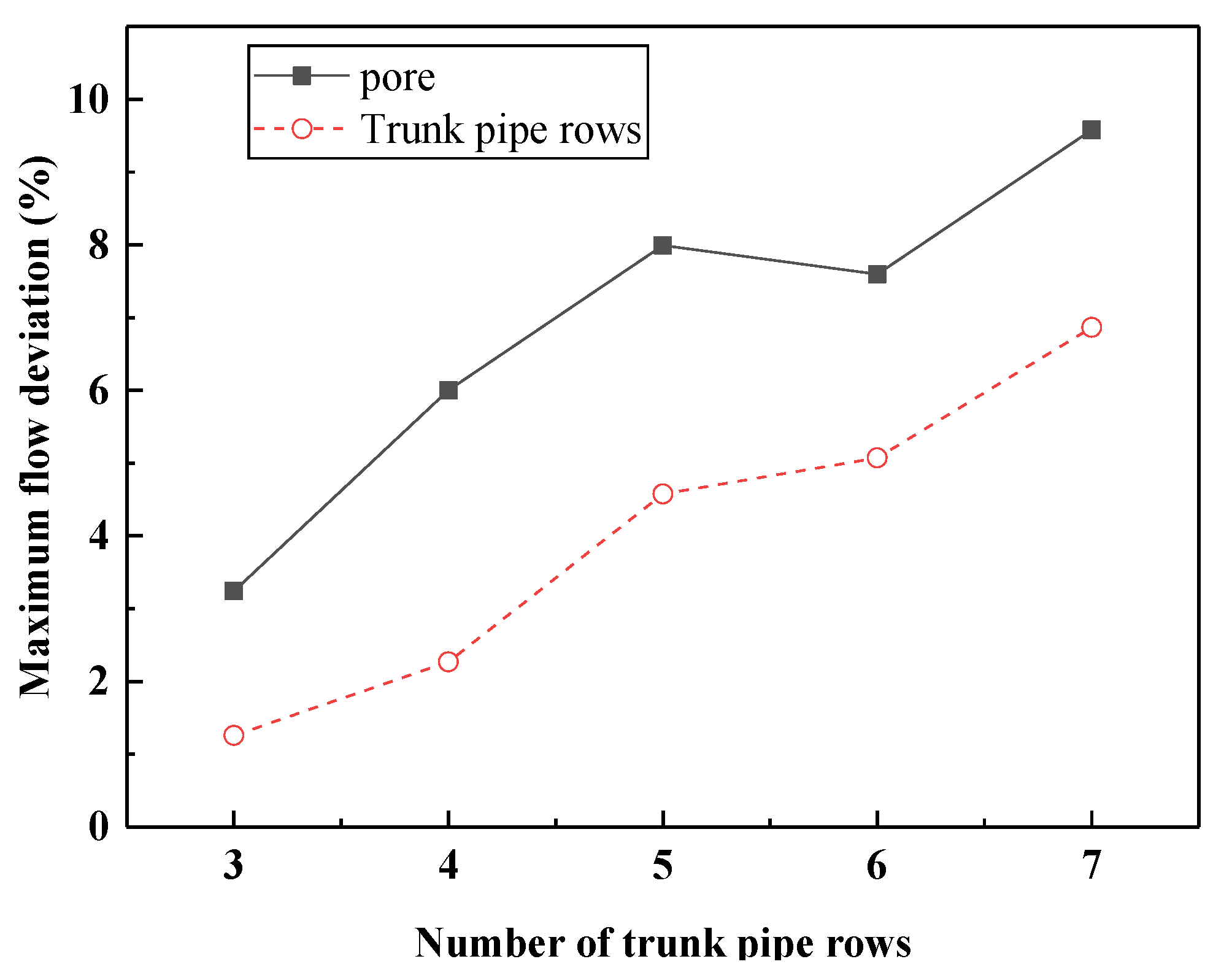


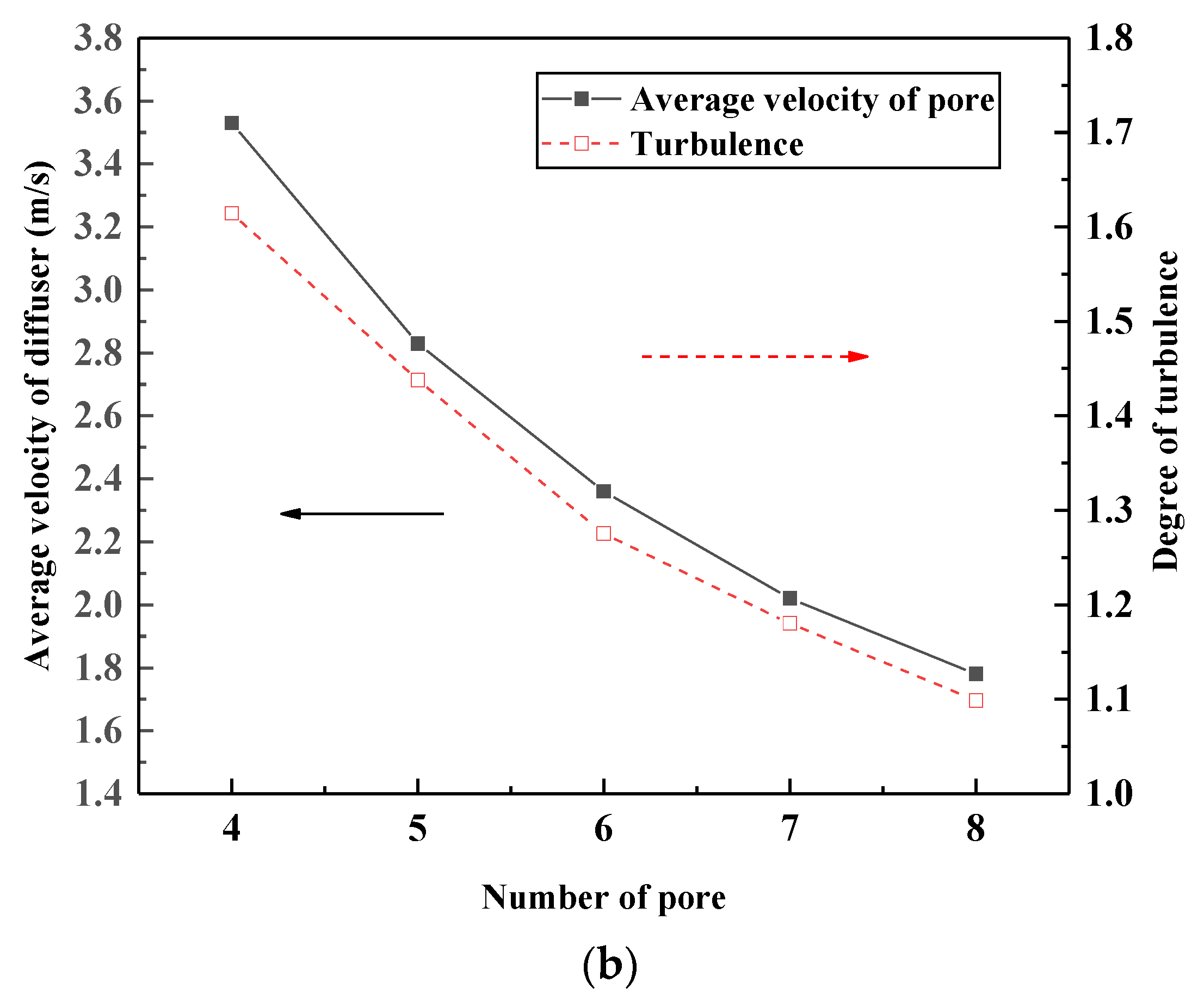

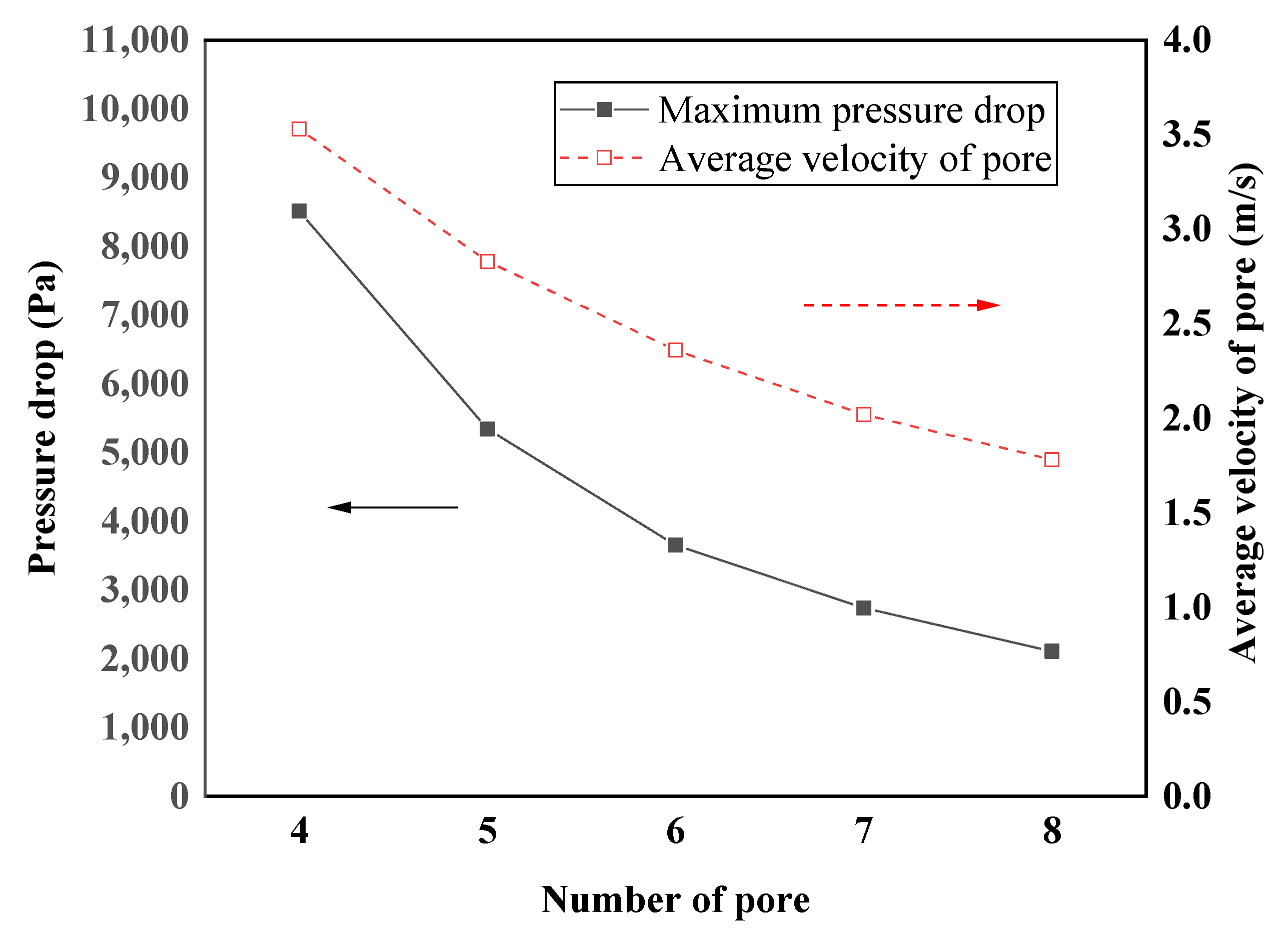


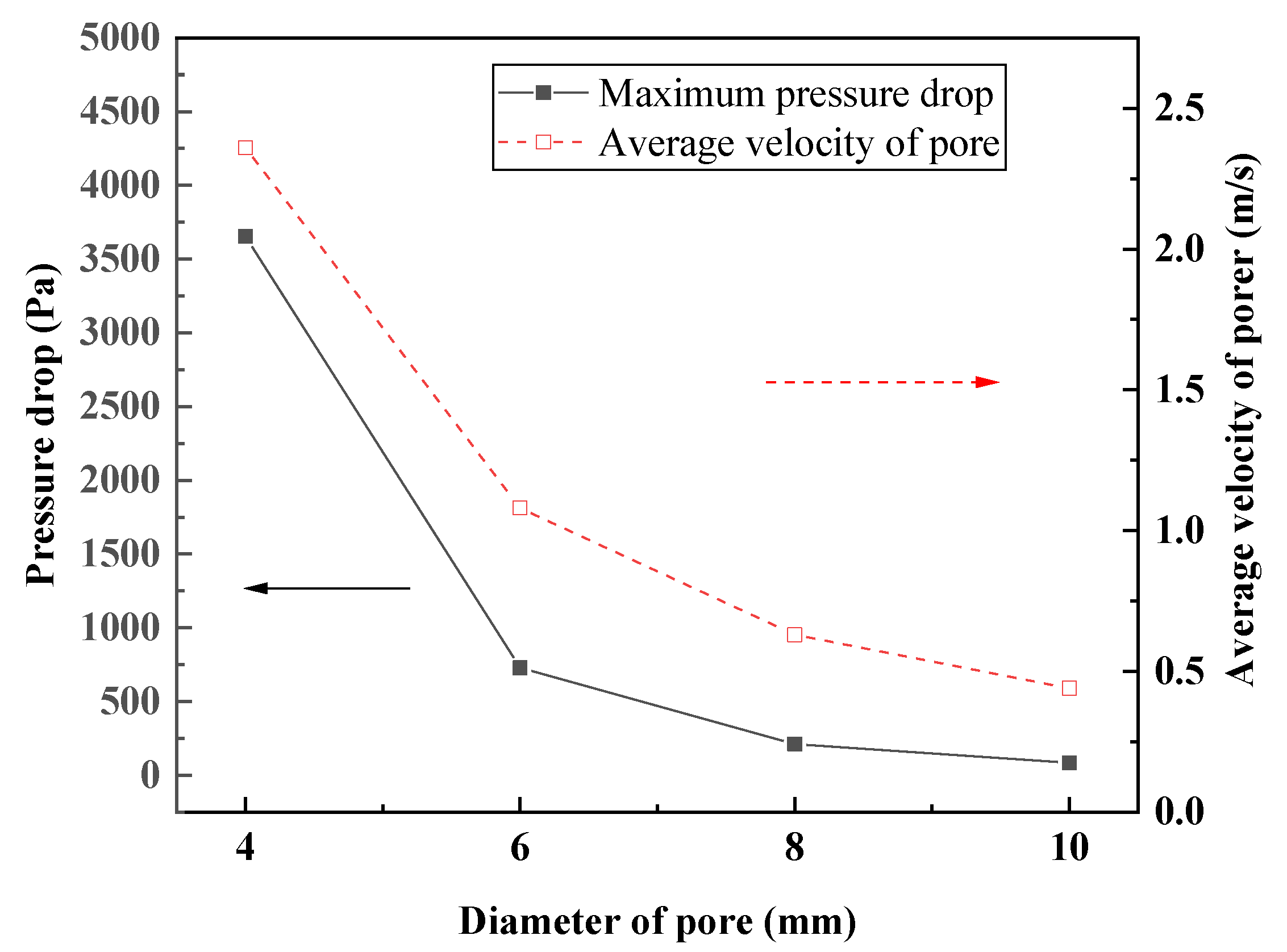
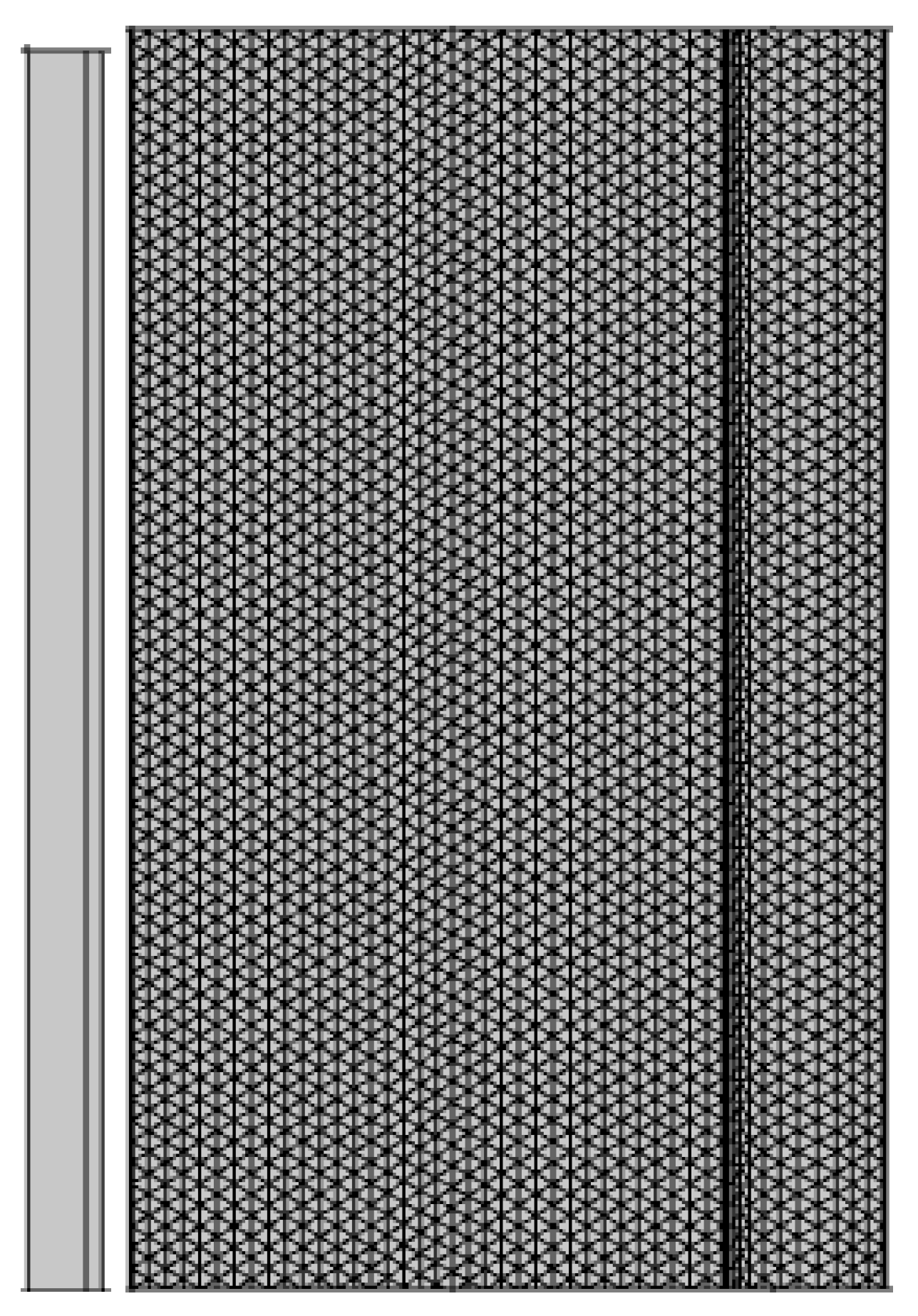
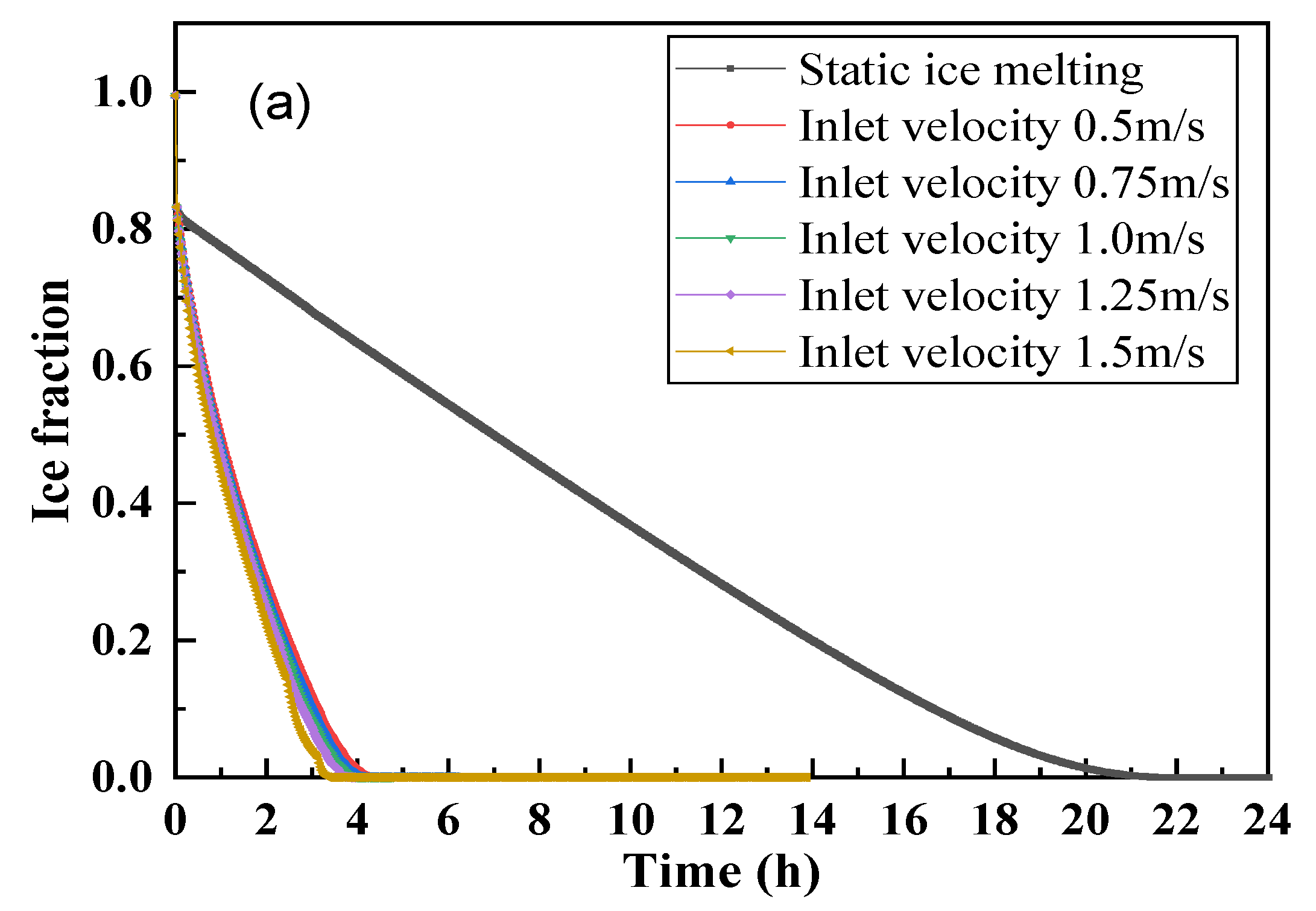
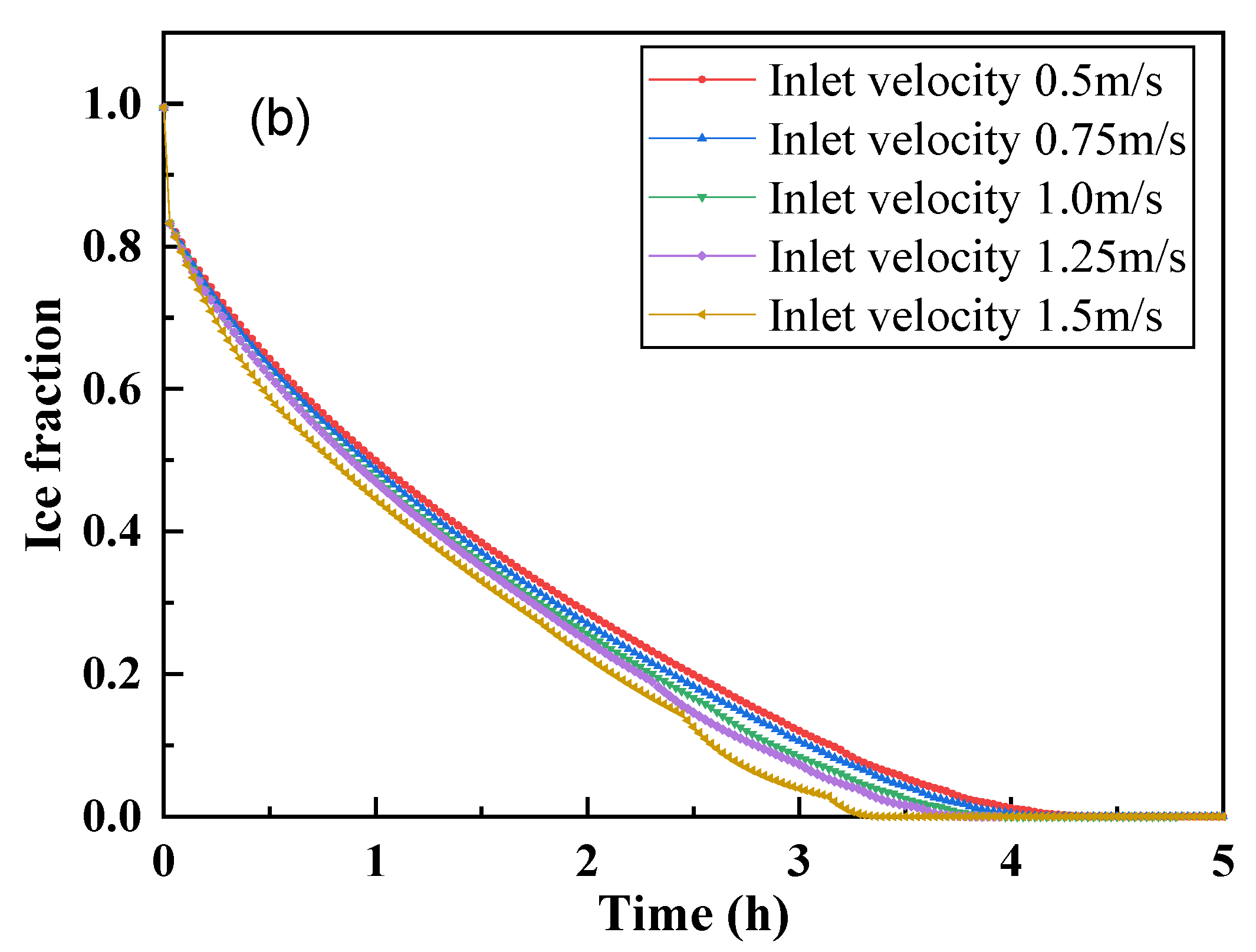
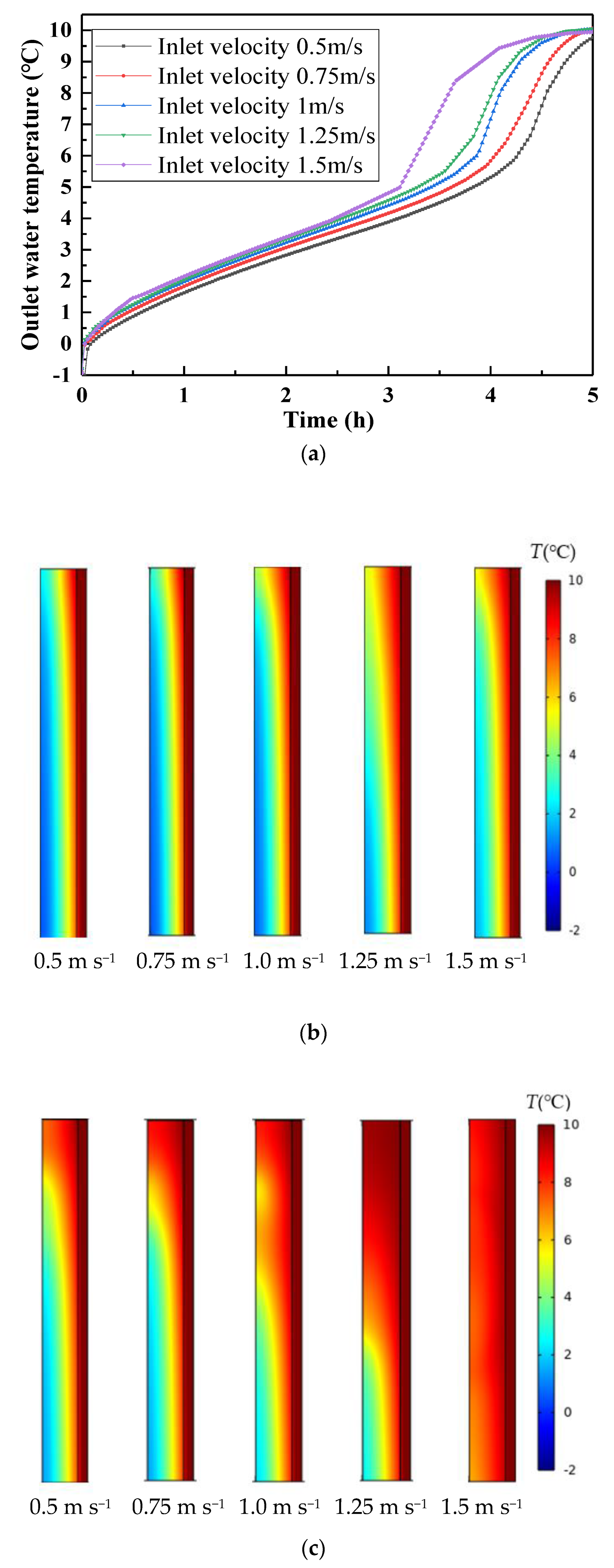
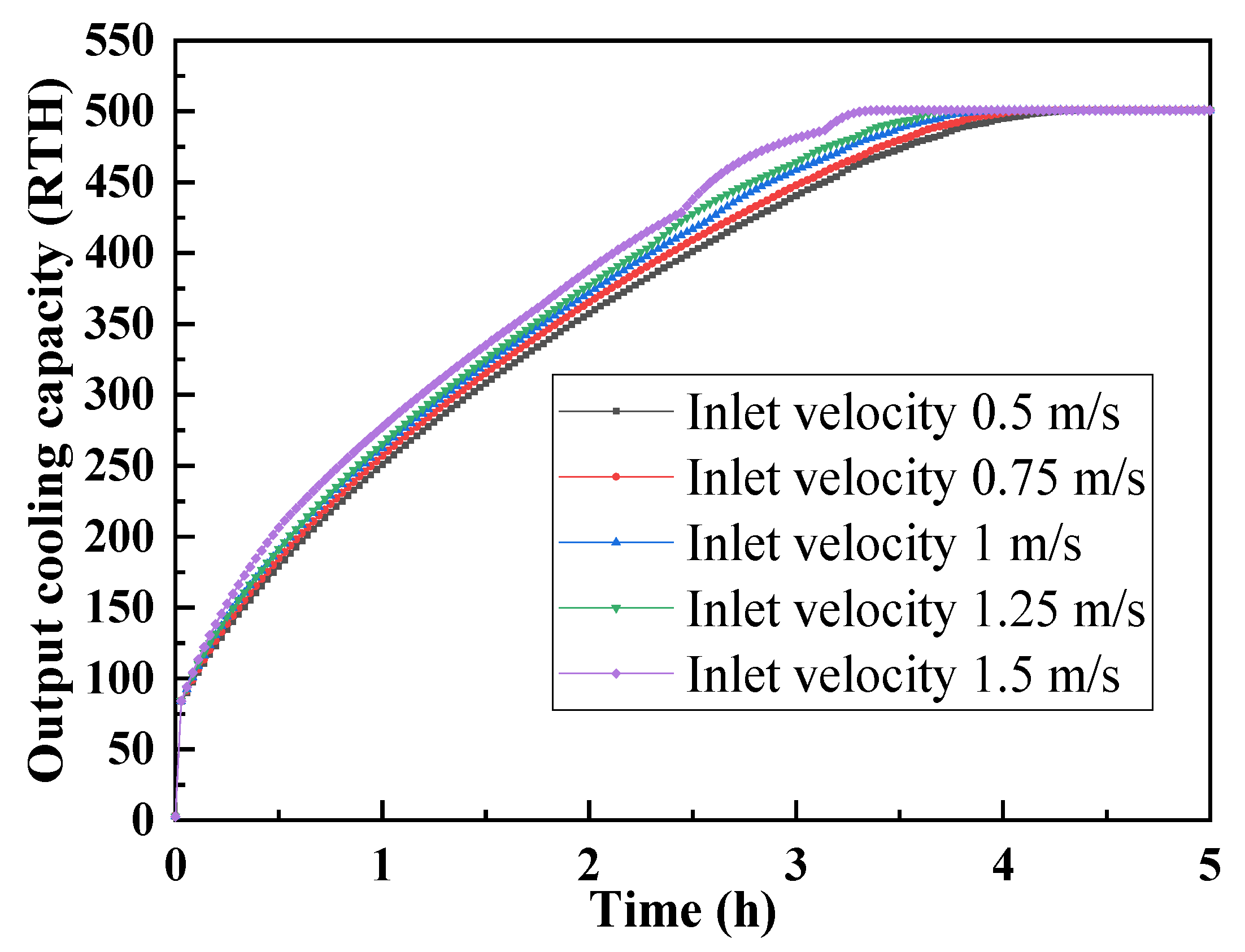
| Description | Boundary Conditions |
|---|---|
| Wall | No slip |
| Main pipe inlet | 1.0 m/s |
| Return water outlet | Pressure outlet |
| Design Number | Number of Trunk Pipes | Perforated Pore Diameter (mm) | Number of Perforated Pores |
|---|---|---|---|
| 1 | 3 | 4 | 6 |
| 2 | 4 | 4 | 6 |
| 3 | 5 | 4 | 6 |
| 4 | 6 | 4 | 6 |
| 5 | 7 | 4 | 6 |
| 6 | 5 | 4 | 4 |
| 7 | 5 | 4 | 5 |
| 8 | 5 | 4 | 7 |
| 9 | 5 | 4 | 8 |
| 10 | 5 | 6 | 6 |
| 11 | 5 | 8 | 6 |
| 12 | 5 | 10 | 6 |
| Description | Temperature (°C) | Density (Kg m−3) | Specific Heat (KJ (kg K)−1) | Thermal Conductivity (W (m K)−1) | Kinematic Viscosity (m2 s−1) |
|---|---|---|---|---|---|
| Liquid water | 10 | 999.7 | 4.191 | 0.574 | 0.000001306 |
| Ice | 0 | 917 | 2.097 | 2.1 | -- |
| Director Inlet Velocity | Calculation Formula | Numerical Simulation Velocity |
|---|---|---|
| 0.5 | 0.016 | |
| 0.75 | 0.024 | |
| 1 | 0.032 | |
| 1.25 | 0.04 | |
| 1.5 | 0.048 |
Publisher’s Note: MDPI stays neutral with regard to jurisdictional claims in published maps and institutional affiliations. |
© 2022 by the authors. Licensee MDPI, Basel, Switzerland. This article is an open access article distributed under the terms and conditions of the Creative Commons Attribution (CC BY) license (https://creativecommons.org/licenses/by/4.0/).
Share and Cite
Li, L.; Wu, Y.; Lu, Y.; Yang, X.; Wang, Q.; Wang, X.; Wang, Y. Numerical Simulation on the Structural Design of a Multi-Pore Water Diffuser during the External Ice Melting Process of an Ice Storage System. Energies 2022, 15, 2181. https://doi.org/10.3390/en15062181
Li L, Wu Y, Lu Y, Yang X, Wang Q, Wang X, Wang Y. Numerical Simulation on the Structural Design of a Multi-Pore Water Diffuser during the External Ice Melting Process of an Ice Storage System. Energies. 2022; 15(6):2181. https://doi.org/10.3390/en15062181
Chicago/Turabian StyleLi, Lei, Yude Wu, Yi Lu, Xiao Yang, Qiyang Wang, Xiaoai Wang, and Yulin Wang. 2022. "Numerical Simulation on the Structural Design of a Multi-Pore Water Diffuser during the External Ice Melting Process of an Ice Storage System" Energies 15, no. 6: 2181. https://doi.org/10.3390/en15062181
APA StyleLi, L., Wu, Y., Lu, Y., Yang, X., Wang, Q., Wang, X., & Wang, Y. (2022). Numerical Simulation on the Structural Design of a Multi-Pore Water Diffuser during the External Ice Melting Process of an Ice Storage System. Energies, 15(6), 2181. https://doi.org/10.3390/en15062181







